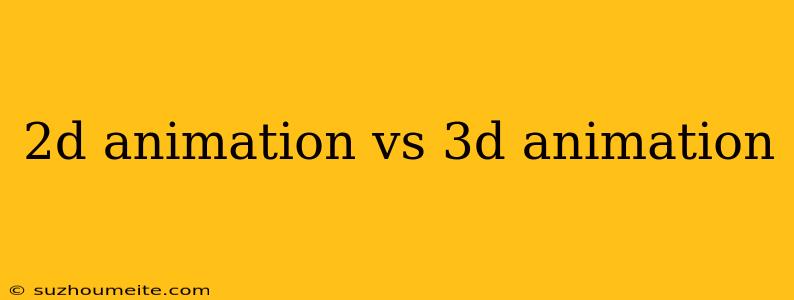2D Animation vs 3D Animation: Which One is Right for You?
Introduction
In the world of animation, there are two main techniques that have been used to create stunning visuals: 2D animation and 3D animation. Both have their own strengths and weaknesses, and each is suited to different types of projects. In this article, we'll explore the differences between 2D and 3D animation, and help you decide which one is right for your next project.
What is 2D Animation?
2D animation, also known as traditional animation, is a technique that involves creating the illusion of movement by manipulating flat, two-dimensional images. This is done by hand-drawing or digitally drawing each frame of the animation, and then playing them back in rapid succession to create the illusion of movement.
Pros of 2D Animation:
- Cost-effective: 2D animation can be less expensive than 3D animation, as it requires less complex software and hardware.
- Flexible: 2D animation can be easily edited and revised, making it ideal for projects that require frequent changes.
- Stylized: 2D animation allows for a more stylized and exaggerated look, which can be perfect for certain types of projects.
Cons of 2D Animation:
- Time-consuming: Creating 2D animation can be a labor-intensive process, as each frame must be drawn individually.
- Limited depth: 2D animation can lack depth and realism, making it less suitable for projects that require a more realistic look.
What is 3D Animation?
3D animation, also known as computer-generated imagery (CGI), is a technique that involves creating three-dimensional models and environments using computer software. These models are then animated using a variety of techniques, such as keyframe animation or motion capture.
Pros of 3D Animation:
- Realistic: 3D animation can create highly realistic and detailed environments and characters.
- Interactive: 3D animation can be easily integrated with interactive elements, such as video games and virtual reality experiences.
- Scalable: 3D animation can be easily scaled up or down, making it ideal for projects that require a high level of detail.
Cons of 3D Animation:
- Expensive: 3D animation can be expensive, as it requires complex software and hardware.
- Complexity: 3D animation can be complex and require a high level of technical expertise.
When to Use 2D Animation:
- Cartoons and anime: 2D animation is perfect for creating stylized and exaggerated characters and environments.
- Explainer videos: 2D animation is ideal for creating simple, easy-to-understand explainer videos.
- Advertising and commercials: 2D animation can be used to create eye-catching and attention-grabbing ads.
When to Use 3D Animation:
- Feature films and video games: 3D animation is perfect for creating highly realistic and detailed environments and characters.
- Architectural visualization: 3D animation can be used to create detailed and realistic models of buildings and structures.
- Product demos and simulations: 3D animation can be used to create highly realistic product demos and simulations.
Conclusion
In conclusion, both 2D and 3D animation have their own strengths and weaknesses, and each is suited to different types of projects. By understanding the pros and cons of each technique, you can make an informed decision about which one is right for your next project. Whether you're creating a cartoon, a feature film, or a product demo, the right animation technique can help bring your vision to life.
